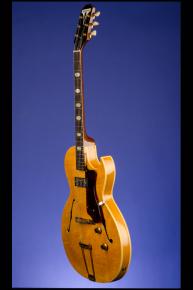Super Rare Blond 1961 Epiphone Windsor.
1961 Epiphone Windsor E-351 TN.
This super lightweight 16 3/8-inch-wide thinline body guitar weighs just 5.20 lbs. and has a single-bound (top and bottom) laminated birds-eye/flamed maple top with two 'f' holes edged in white. Laminated light birds-eye maple back and maple sides. One-piece mahogany neck with a very fast thin-to-medium profile. Brazilian rosewood fretboard with 20 jumbo frets and inlaid large oval pearl position markers. Headstock with metal Epiphone logo plate. Three-layer, dome-shaped (black over white) plastic truss-rod cover with two screws. Individual single-line Kluson Deluxe tuners with single-ring keystone buttons (stamped on the underside "D-169400 / Patent No."). Single Epiphone mini-humbucker pickup with black plastic surround and an output of 6.96k. Tortoiseshell celluloid pickguard. Two controls (one volume, one tone) on lower treble bout. Gold plastic bell-shaped knobs with metal tops. Later Gibson Tune-O-Matic bridge on original height-adjustable rosewwood base and trapeze tailpiece with three horizontal lines on cross-bar. All hardware gold-plated. Printed light-blue paper label inside the bass f-hole with the model number "Windsor-Nat. E351-TN" (typed) and the serial number "X- (written in ink) 4733-18" (stamped in black). Inside the treble f-hole, stamped in black is the FON number "X-4733-18". We think that the nut has possibly been replaced or re-set. There is some very fine finish checking on the top, otherwise this wonderful guitar is in near mint (9.25) condition. Housed in the original four-latch, shaped black hardshell case with orange plush lining (9.25).
It would appear that the person at Epiphone, Kalamazoo in 1961 who was responsible for typing and stamping the interior labels must have had a very late night and was suffering from severe sleep deprivation - that would be our explanation of the FON number being used as the serial number (DJB).
A prime example, in the rare natural color, of one of the fifty-one Windsor E-351 TN's made -- the metal peghead logo plate was discontinued by 1963. The Windsor is similar in body style to Gibson's ES-125T, but has the more deluxe feature of a mini humbucker. Epiphone also produced the Sorrento, a very similar guitar but without the deluxe feature of gold hardware.
The 1961 Epiphone catalog lists the single pickup Windsor with natural finish at $225 compared to the Sorrento single pickup in natural which was listed at $210.
"At the first sign of Epiphone's acceptance by dealers,Gibson expanded the line. The Windsor, introduced in 1959, attempted to revive Gibson's ES-225T, a thin-bodied pointed-cutaway model that had gone out of production in 1958." (Walter Carter. The Epiphone Guitar Book, p.48).
"The Gibson-Epi line couldn't have debuted at a better time. By the end of the fifties, rock 'n' roll had brought the electric guitar into the mainstream of popular music. And by the early sixties, the rising folk music scene did the same for the acoustic guitar. The music was mostly of the three-cord variety, easy to play, and the guitar quickly became the instrument of the people. Everybody palyed guitar, and Gibson met the growing demand with an explosion of new models in both the Epi and Gibson lines." (Walter Carter. Epiphone - The Complete History, p.64).












